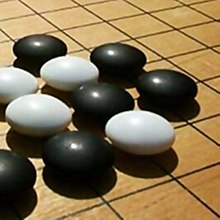Go/What you need to play
Equipment
[edit | edit source]The equipment which is used to play Go has remained almost the same throughout the game's four thousand year history and is simple enough that you could make do with things found around your own home.
Board
[edit | edit source]
The Board, or Goban (碁盤) in Japanese, is the surface on which the game is played. Printed on this board is a grid, usually nineteen-by-nineteen though other sizes are common. Games are also frequently played on smaller boards, traditionally 9x9 and 13x13. It's possible to experiment with even more unusual board geometries. A traditional Goban has four feet and sits on the floor, but many modern boards have no feet and are designed for tabletop use. These are also called table boards. Beginning players often play on paper using a thirteen-by-thirteen grid, allowing them to get the hang of the game without spending a lot of money on a board or time on more complicated, full-board games. Physical gobans are traditionally made of light-colored wood. They range from cheap models (folding boards, roll-up mats) to club-quality boards (solid wood ranging up to 4" thick or so) and truly beautiful traditional "floor boards," which have legs and are often constructed with great care from exotic woods such as the coveted "Kaya."
Stones
[edit | edit source]
Stones(also known as Seeds) are the game pieces of Go and are placed on the intersections of the lines on a board. The stones are black and white, generally made from glass, plastic, marble, slate, or clamshell, and come in many sizes ranging from 7mm to 11.3mm in thickness. A set of Go stones can cost anywhere from a few dollars to thousands of dollars. The highest-quality stones are made from slate (black) and specially carved clamshells (white), and cost hundreds of dollars per set. A full set of stones consists of 181 black stones and 180 white stones. Stones are uniform and round, reminiscent of an oversized M&M candy. It is traditional to have a bowl for each player's stones (these are often carved pleasingly from attractive woods), using the upturned lid of the bowl to store captured prisoner stones of the opposite color during play.
Bowls
[edit | edit source]
Bowls are just a place to keep your stones while they are not on the board. They are not a necessary part of the equipment. Bowls are normally made from wood or plastic and are usually the cheapest part of a set. Some boards have drawers to keep stones in so you don't have to have bowls, however most do not. Captured stones are kept in the lid of the bowl in Japanese and Korean rules. In Chinese rules, you may place them back in your bowl.
More information on boards and stones from Sensei's Library.
Playing on a computer
[edit | edit source]If you want to play Go but don't want to buy/make/borrow the equipment needed you could also try playing on a digital board such as qGo.